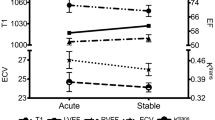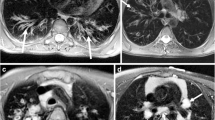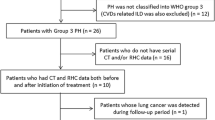Abstract
Background
Cystic fibrosis (CF) is a common genetic disease in Caucasians. Chronic pulmonary disease with progressive destruction of the pulmonary parenchyma is two of the major morbidities, but the relationship between clinical severity of CF and aortopulmonary collateral blood flow has not been assessed.
Objective
The purpose of this study is to measure changes in aortopulmonary collateral blood flow by phase-contrast magnetic resonance imaging (MRI) in children with CF across the spectrum of disease severity as measured by the forced expiratory volume in one second as percent predicted value (FEV1% predicted).
Materials and methods
Sixteen patients with CF were prospectively evaluated. Eight were classified as having mild CF lung disease (FEV1 ≥80% predicted) and eight were classified as having moderate to severe CF lung disease (FEV1 <80% predicted). Seventeen age- and gender-matched non-CF subjects without cardiac or lung disease served as controls. Phase-contrast flow was measured at the ascending aorta, main pulmonary artery and both pulmonary arteries. Aortopulmonary collateral blood flow was calculated for each subject. The relationship between collateral flow and FEV1% predicted was modeled using nonparametric regression. Group differences were assessed by analysis of variance.
Results
Aortopulmonary collateral blood flow began to increase as FEV1% predicted in subjects with CF fell below 101.5% with significant further increase in the aortopulmonary collateral blood flow in the subjects with CF with moderate to severe lung disease compared to controls (0.89 vs. 0.20 L/min, P < 0.0001). Aortopulmonary collateral blood flow correlated negatively with FEV1% predicted (r=0.70, P = 0.0050) confirming its relationship to this established marker of disease severity. There was no statistically significant difference in results obtained from two independent observers.
Conclusion
These preliminary findings suggest that phase-contrast MRI can be performed reliably with consistent results and without interobserver variability. While the aortopulmonary collateral blood flow is within the normal range in subjects with mild CF disease, it begins to increase even when lung function is still in the normal range. A significant increase in the aortopulmonary collateral blood flow compared to controls is measured in patients with moderate to severe CF lung disease. The studies support the notion that aortopulmonary collateral blood flow may serve as a novel and sensitive biomarker of early pulmonary disease in cystic fibrosis.




Similar content being viewed by others
Abbreviations
- APCBF:
-
Aortopulmonary collateral blood flow
- ANOVA:
-
Analysis of variance
- CF:
-
Cystic fibrosis
- CI:
-
95% confidence interval
- FEV1%:
-
Forced expiratory volume in one second (percent predicted)
- FEF25–75% :
-
Forced expiratory flow25–75% (percent predicted)
- FVC:
-
Forced vital capacity
- ICC:
-
Intraclass correlation coefficient
References
Ratjen F, Doring G (2003) Cystic fibrosis. Lancet 361:681–689
Fraser KL, Tullis DE, Sasson Z et al (1999) Pulmonary hypertension and cardiac function in adult cystic fibrosis: role of hypoxemia. Chest 115:1321–1328
Hoshino M, Takahashi M, Aoike N (2001) Expression of vascular endothelial growth factor, basic fibroblast growth factor, and angiogenin immunoreactivity in asthmatic airways and its relationship to angiogenesis. J Allergy Clin Immunol 107:295–301
Salvato G (2001) Quantitative and morphological analysis of the vascular bed in bronchial biopsy specimens from asthmatic and non-asthmatic subjects. Thorax 56:902–906
Hashimoto M, Tanaka H, Abe S (2005) Quantitative analysis of bronchial wall vascularity in the medium and small airways of patients with asthma and COPD. Chest 127:965–972
Li X, Wilson JW (1997) Increased vascularity of the bronchial mucosa in mild asthma. Am J Respir Crit Care Med 156:229–233
McDonald DM (2001) Angiogenesis and remodeling of airway vasculature in chronic inflammation. Am J Respir Crit Care Med 164:S39–S45
Vrugt B, Wilson S, Bron A et al (2000) Bronchial angiogenesis in severe glucocorticoid-dependent asthma. Eur Respir J 15:1014–1021
Csete ME, Chediak AD, Abraham WM et al (1991) Airway blood flow modifies allergic airway smooth muscle contraction. Am Rev Respir Dis 144:59–63
Bogren HG, Klipstein RH, Firmin DN et al (1989) Quantitation of antegrade and retrograde blood flow in the human aorta by magnetic resonance velocity mapping. Am Heart J 117:1214–1222
Bland JM, Altman DG (1986) Statistical methods for assessing agreement between two methods of clinical measurement. Lancet 1:307–310
Shrout PE, Fleiss JL (1979) Intraclass correlations: uses in assessing rater reliability. Psychol Bull 86:420–428
Ramsay JO (2005) Functional data analysis, 2nd edn. Springer, New York
Ley S, Puderbach M, Fink C et al (2005) Assessment of hemodynamic changes in the systemic and pulmonary arterial circulation in patients with cystic fibrosis using phase-contrast MRI. Eur Radiol 15:1575–1580
Sweet SC, Spray TL, Huddleston CB et al (1997) Pediatric lung transplantation at St. Louis Children’s Hospital, 1990–1995. Am J Respir Crit Care Med 155:1027–1035
Remy J, Deschildre F, Artaud D et al (1997) Bronchial arteries in the pig before and after permanent pulmonary artery occlusion. Invest Radiol 32:218–224
McColley SA, Stellmach V, Boas SR et al (2000) Serum vascular endothelial growth factor is elevated in cystic fibrosis and decreases with treatment of acute pulmonary exacerbation. Am J Respir Crit Care Med 161:1877–1880
Charan NB, Carvalho P (1997) Angiogenesis in bronchial circulatory system after unilateral pulmonary artery obstruction. J Appl Physiol 82:284–291
Watts KD, McColley SA (2011) Elevated vascular endothelial growth factor is correlated with elevated erythropoietin in stable, young cystic fibrosis patients. Pediatr Pulmonol 46:683–687
Verhaeghe C, Tabruyn SP, Oury C et al (2007) Intrinsic pro-angiogenic status of cystic fibrosis airway epithelial cells. Biochemical and biophysical research communications. Biochem Biophys Res Commun 356:745–749
Fadel E, Mazmanian GM, Chapelier A et al (1998) Lung reperfusion injury after chronic or acute unilateral pulmonary artery occlusion. Am J Respir Crit Care Med 157:1294–1300
Fadel E, Wijtenburg E, Michel R et al (2006) Regression of the systemic vasculature to the lung after removal of pulmonary artery obstruction. Am J Respir Crit Care Med 173:345–349
Norgaard MA, Alphonso N, Cochrane AD et al (2006) Major aorto-pulmonary collateral arteries of patients with pulmonary atresia and ventricular septal defect are dilated bronchial arteries. Eur J Cardiothorac Surg 29:653–658
Koch AE, Polverini PJ, Kunkel SL et al (1992) Interleukin-8 as a macrophage-derived mediator of angiogenesis. Science 258:1798–1801
Keane MP, Arenberg DA, Lynch JP 3rd et al (1997) The CXC chemokines, IL-8 and IP-10, regulate angiogenic activity in idiopathic pulmonary fibrosis. J Immunol 159:1437–1443
Belperio JA, Keane MP, Burdick MD et al (2005) Role of CXCR2/CXCR2 ligands in vascular remodeling during bronchiolitis obliterans syndrome. J Clin Invest 115:1150–1162
Ku DD, Zaleski JK, Liu S et al (1993) Vascular endothelial growth factor induces EDRF-dependent relaxation in coronary arteries. Am J Physiol 265:H586–H592
He H, Venema VJ, Gu X et al (1999) Vascular endothelial growth factor signals endothelial cell production of nitric oxide and prostacyclin through flk-1/KDR activation of c-Src. J Biol Chem 274:25130–25135
Tsurumi Y, Murohara T, Krasinski K et al (1997) Reciprocal relation between VEGF and NO in the regulation of endothelial integrity. Nat Med 3:879–886
Lew CD, Alley MT, Bammer R et al (2007) Peak velocity and flow quantification validation for sensitivity-encoded phase-contrast MR imaging. Acad Radiol 14:258–269
Chernobelsky A, Shubayev O, Comeau CR et al (2007) Baseline correction of phase contrast images improves quantification of blood flow in the great vessels. J Cardiovasc Magn Reson 9:681–685
Conflict of interest
None.
Author information
Authors and Affiliations
Corresponding author
Rights and permissions
About this article
Cite this article
Fleck, R., McPhail, G., Szczesniak, R. et al. Aortopulmonary collateral flow in cystic fibrosis assessed with phase-contrast MRI. Pediatr Radiol 43, 1279–1286 (2013). https://doi.org/10.1007/s00247-013-2708-z
Received:
Revised:
Accepted:
Published:
Issue Date:
DOI: https://doi.org/10.1007/s00247-013-2708-z




